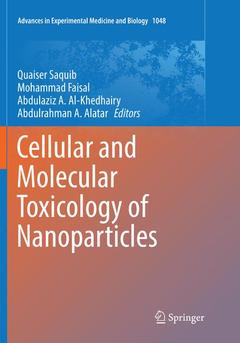Cellular and Molecular Toxicology of Nanoparticles, Softcover reprint of the original 1st ed. 2018 Advances in Experimental Medicine and Biology Series, Vol. 1048
Coordonnateurs : Saquib Quaiser, Faisal Mohammad, Al-Khedhairy Abdulaziz A., Alatar Abdulrahman A.

This edited book is a compilation of findings on the molecular and cellular toxicity of nanoparticles (NPs) in animal cell, human cells, invertebrates. The varied selection of test models will provide better understanding about the horizon of NPs toxicity. Interaction of NPs with cells and its organelles can induce toxicological consequences, including transcriptional and translational alterations, DNA damage, cytotoxicity, oxidative stress, mitochondrial dysfunction and cell death. NPs can get internalized in cells through phagocytosis, macropinocytosis, receptor-mediated endocytosis and passive penetration, which can affect varied cell types.
Readers will be benefited with the compilations on basic and molecular facet of NPs toxicity. The chapters will provide a comprehensive information on the state-of-the-art methodologies. The application of toxicogenomic approaches, which is already established in nanotoxicology, has been given special consideration to unravel the toxicodynamics of nanomaterials. Among these approaches, the high-throughput RNA sequencing (RNA-Seq), which is able to build a complete map of transcriptome across different cell types and perturbations upon NPs exposure has been included. The readers are also introduced to the less studied topic on the adsorption of biomolecules (mainly proteins) on the NPs surface, constituting the so-called ?biomolecular corona?.
The book has been designed for scientists engaged in NPs toxicity research. Nonetheless, it should be of interest to a variety of scientific disciplines including marine biology, environmental pollution, genetics, pharmacology, medicine, drug and food material sciences, consumer products. Also, the compilations will be of interest to the environmental watchdogs, federal regulators, risk assessors and the policy makers.
Dr. Mohammad Faisal is an Assistant Professor in the Department of Botany & Microbiology, King Saud University,Riyadh, Saudi Arabia. He received his PhD degree in Botany from the AMU, India. He is a well-known plant biotechnologist and an active researcher also worked as Postdoctoral Fellow at the Centro de Investigaciones Biologicas, Madrid, Spain and Young Scientist at AMU, Aligarh, India. He availed several national fellowships during his doctoral work. Dr. Faisal has been awarded Plant Biotechnologist Award-2017 by the SESR, India and Scientist of the Year Award-2015 by the NESA. He has published over 64 research articles and these papers have been cited over 1362 times with Google h index of 23. He holds life membership of several academic societies and fellow of the SESR. He is in the editorial board of the several peer-reviewed international journals.
Professor Abdulaziz A. Al-Khedhairy is currently serving as Director of Twasol Research Excellence Program in King Saud University, Riyadh, Saudi Arabia. He has been appointed at several key academic and administrative positions
Date de parution : 01-2019
Ouvrage de 346 p.
17.8x25.4 cm
Date de parution : 03-2018
Ouvrage de 346 p.
17.8x25.4 cm
Thèmes de Cellular and Molecular Toxicology of Nanoparticles :
Mots-clés :
Nanotoxicity; Nanoparticles; Genotoxicity; Cell Death; Apoptosis; Transciptomics



